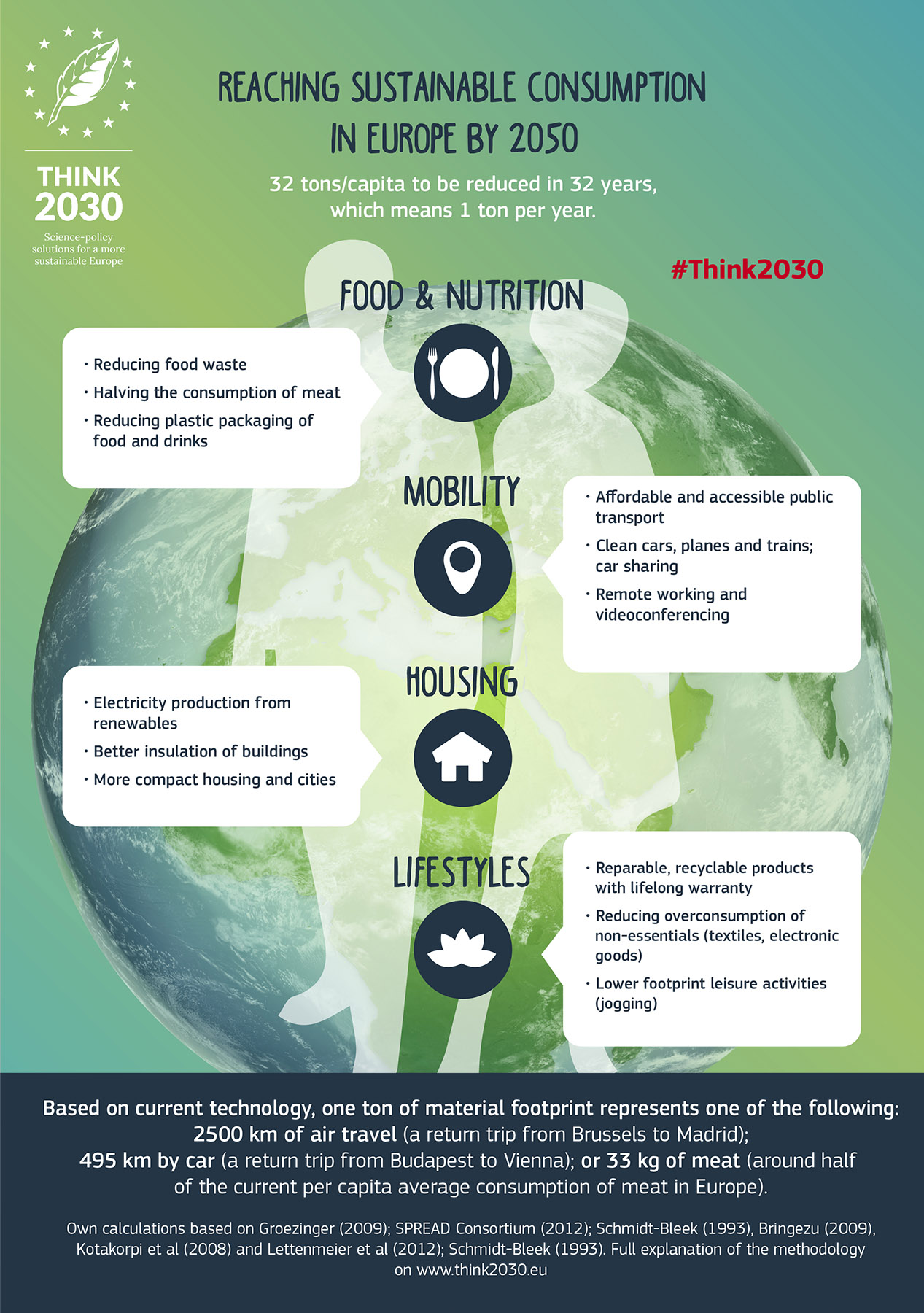This report and its recommendations come from the Think 2030 conference held in October 2018 in Brussels and were originally published in November. Stay tuned as we publish the report in weekly instalments on our website.
In light of planetary boundaries, the ways that we consume today – at a high rate and along a largely linear trajectory (take-make-dispose) – are not sustainable. In the simplest terms, we would need almost three earths to support the global economy if European consumption patterns were replicated throughout the planet.
In fact, each European will have to reduce by 80% the amount of natural resources they currently use for nutrition, housing, mobility and leisure by 2050. This means a reduction of material footprint per capita by 1 tonne annually during the next 32 years.
This can be achieved through a combination of efficiency and sufficiency. Greater efficiency is required to reduce the material footprint of everyday consumption, while sufficiency (i.e. reducing overall consumption) will be also needed for those items whose footprint cannot be brought to an acceptable level by efficiency only.
According to the OECD, governments play an essential role in encouraging people to factor the environment into their everyday lives and purchases. To reach the change at the scale and speed that is required means going well beyond labelling to include selective “choice editing” i.e. ensuring that products put on the market are both safe for consumers and in line with planetary boundaries. A recent example of action to trigger a change in consumption is the decision by the European Parliament to ban certain single-use plastics such as plastic cotton buds, straws, plates and cutlery.
Benefits and trade-offs
Increasing the sustainability of consumption should not come at the expense of other societal objectives such as social justice, health and quality of life. Sometimes there will be a win-win: a greener approach to travel for work might, for instance, improve work-life balance and reduce exposure to air pollution. Reducing meat consumption is likely to improve the health status of those individuals whose consumption goes beyond what is recommended as part of a healthy diet.
Sometimes, there might be trade-offs, which need to be addressed through carefully crafted policies: for instance, taking into account challenges linked with the availability, suitability and affordability of more sustainable products will be essential.
Policies must also anticipate differential impacts on households, livelihoods and lifestyles and put in place supporting policies to ensure a just transition for all.
The infographic below illustrates the challenges ahead and proposes concrete solutions for reaching sustainable consumption.

Through the Single market, the EU has a long-standing competence overconsumption issues and has a good menu of policy tools to build from, including the Ecodesign Directive and the Ecolabel and EMAS regulations.
The EU Action Plan for the Circular Economy and the 2008 Sustainable Consumption and Sustainable Industrial Policy Action Plan look ahead at the choices and some of the measures required.
However, the bulk of concrete interventions have focused on supply-side measures addressing the negative impacts of the current linear economy, including improving the resource and energy efficiency of production and end-of-life management of products.
There has been much less focus on the demand side. Some progress has been made, for example in the uptake of recycling. However, productivity gains and cost savings in one area often lead to increased consumption and resource use in another – the so-called “rebound effect”. This can significantly reduce the effectiveness of consumers’ “green” choices.
So far, general consumption patterns have remained unchanged and environmental impacts related to consumption remain unsustainably high despite those demand-side measures that have focused on raising consumer awareness and encouraging more reliable and comparable product information. On their own, these efforts do not seem to result in the required behavioural changes.
Action is required at different levels of governance, with EU strategic framing and support for interventions that will be developed particularly within member states and in the private sector.
Both household consumption, accounting for about 60% of GDP within the EU, and public sector consumption, another 14%, need to be included. Demographic trends, such as the increased level of single households often associated with more wasteful consumption practices, also need to be taken into account.
A combination of different policy instruments needs to be deployed. Many can build on existing approaches, such as consumer engagement and information and standards for public procurement. Others will involve extending the field of intervention more widely, such as introducing environmental tax reform, designed to shift the burden of taxation from labour to one based on the use of natural resources and energy.
| A combination of different policy instruments needs to be deployed |
Well-designed taxes, fees and other charges or subsidies can successfully promote business models contributing to closing the loop on materials and resource use. Examples might include differential VAT rates, which could explicitly favour repair and renovation services, and more support for leasing and sharing of products with a sizeable footprint.
Initiatives aimed at encouraging behavioural change can take advantage of technological innovation, such as aspects of digitalisation – potentially empowering better informed and more motivated consumers. Measures can apply insights from consumer behaviour studies to ensure that interventions, whilst ethical, are well-designed and targeted.
Importantly, behavioural insights might help address the prevailing gap between consumer knowledge and action when it comes to sustainable consumption. The OECD has suggested that promising policy domains for the application of behavioural insights include resource efficiency and waste management, transport, water and environmental compliance.
These demand-side measures require the field of choice to include a better range of more sustainable options. Reinforced incentives to design and build products with lower impact and longer functional lives will be essential, utilising more ambitious labelling schemes and product standards where the EU has a key part to play globally as well as internally.
Recommendation for consumption 2030
- A comprehensive European policy for sustainable consumption, covering nutrition, mobility, housing and lifestyles, as a complement to the current circular economy package, and aiming at an 80% reduction in per capita material footprint by 2050.
| About Think 2030#Think2030 is an evidence-based, non-partisan platform of 100 policy experts from European think tanks, civil society, the private sector and local authorities.Based on a series of papers covering all major environmental challenges (listed below), the 30 actions, contained in the #think2030 Action plan, will enable European citizens to live prosperous, peaceful and healthy lives by 2050, while sustaining the 80% reduction in per capita resource use. For more information visit www.Think2030.eu |

